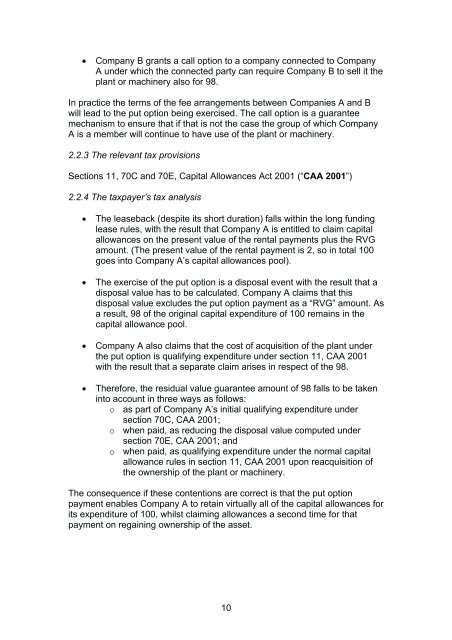Examples of how the GAAR applies to tax arrangements
Examples of how the GAAR applies to tax arrangements
Examples of how the GAAR applies to tax arrangements
Create successful ePaper yourself
Turn your PDF publications into a flip-book with our unique Google optimized e-Paper software.
• Company B grants a call option <strong>to</strong> a company connected <strong>to</strong> Company<br />
A under which <strong>the</strong> connected party can require Company B <strong>to</strong> sell it <strong>the</strong><br />
plant or machinery also for 98.<br />
In practice <strong>the</strong> terms <strong>of</strong> <strong>the</strong> fee <strong>arrangements</strong> between Companies A and B<br />
will lead <strong>to</strong> <strong>the</strong> put option being exercised. The call option is a guarantee<br />
mechanism <strong>to</strong> ensure that if that is not <strong>the</strong> case <strong>the</strong> group <strong>of</strong> which Company<br />
A is a member will continue <strong>to</strong> have use <strong>of</strong> <strong>the</strong> plant or machinery.<br />
2.2.3 The relevant <strong>tax</strong> provisions<br />
Sections 11, 70C and 70E, Capital Allowances Act 2001 (“CAA 2001”)<br />
2.2.4 The <strong>tax</strong>payer’s <strong>tax</strong> analysis<br />
• The leaseback (despite its short duration) falls within <strong>the</strong> long funding<br />
lease rules, with <strong>the</strong> result that Company A is entitled <strong>to</strong> claim capital<br />
allowances on <strong>the</strong> present value <strong>of</strong> <strong>the</strong> rental payments plus <strong>the</strong> RVG<br />
amount. (The present value <strong>of</strong> <strong>the</strong> rental payment is 2, so in <strong>to</strong>tal 100<br />
goes in<strong>to</strong> Company A’s capital allowances pool).<br />
• The exercise <strong>of</strong> <strong>the</strong> put option is a disposal event with <strong>the</strong> result that a<br />
disposal value has <strong>to</strong> be calculated. Company A claims that this<br />
disposal value excludes <strong>the</strong> put option payment as a “RVG” amount. As<br />
a result, 98 <strong>of</strong> <strong>the</strong> original capital expenditure <strong>of</strong> 100 remains in <strong>the</strong><br />
capital allowance pool.<br />
• Company A also claims that <strong>the</strong> cost <strong>of</strong> acquisition <strong>of</strong> <strong>the</strong> plant under<br />
<strong>the</strong> put option is qualifying expenditure under section 11, CAA 2001<br />
with <strong>the</strong> result that a separate claim arises in respect <strong>of</strong> <strong>the</strong> 98.<br />
• Therefore, <strong>the</strong> residual value guarantee amount <strong>of</strong> 98 falls <strong>to</strong> be taken<br />
in<strong>to</strong> account in three ways as follows:<br />
o as part <strong>of</strong> Company A’s initial qualifying expenditure under<br />
section 70C, CAA 2001;<br />
o when paid, as reducing <strong>the</strong> disposal value computed under<br />
section 70E, CAA 2001; and<br />
o when paid, as qualifying expenditure under <strong>the</strong> normal capital<br />
allowance rules in section 11, CAA 2001 upon reacquisition <strong>of</strong><br />
<strong>the</strong> ownership <strong>of</strong> <strong>the</strong> plant or machinery.<br />
The consequence if <strong>the</strong>se contentions are correct is that <strong>the</strong> put option<br />
payment enables Company A <strong>to</strong> retain virtually all <strong>of</strong> <strong>the</strong> capital allowances for<br />
its expenditure <strong>of</strong> 100, whilst claiming allowances a second time for that<br />
payment on regaining ownership <strong>of</strong> <strong>the</strong> asset.<br />
10

















